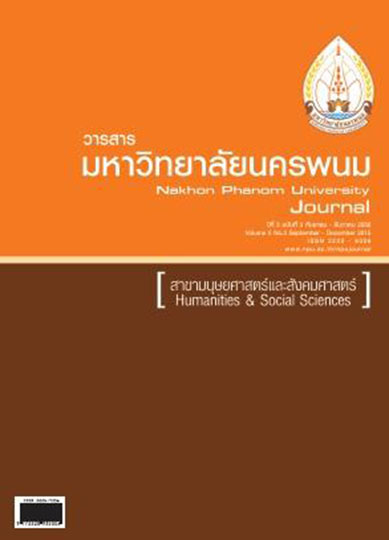ความสัมพันธ์ระหว่างภาวะผู้นำการเปลี่ยนแปลงของผู้บริหารกับวัฒนธรรมองค์กรลักษณะสร้างสรรค์ของโรงเรียนในจังหวัดนครพนม
Main Article Content
Abstract
การวิจัยครั้งนี้มีวัตถุประสงค์เพื่อ 1) ศึกษาระดับภาวะผู้นำการเปลี่ยนแปลงของผู้บริหารและระดับวัฒนธรรมองค์กรลักษณะสร้างสรรค์ของโรงเรียน 2) เปรียบเทียบภาวะผู้นำการเปลี่ยนแปลงของผู้บริหารและวัฒนธรรมองค์กรลักษณะสร้างสรรค์ของโรงเรียน3) ศึกษาความสัมพันธ์ระหว่างภาวะผู้นำการเปลี่ยนแปลงของผู้บริหารกับวัฒนธรรมองค์กรลักษณะสร้างสรรค์ของโรงเรียน 4) สร้างสมการพยากรณ์วัฒนธรรมองค์กรลักษณะสร้างสรรค์ของโรงเรียนโดยใช้ภาวะผู้นำการเปลี่ยนแปลงของผู้บริหารเป็นตัวพยากรณ์ กลุ่มตัวอย่างได้แก่ ครูผู้สอนในจังหวัดนครพนม ปีการศึกษา 2556 จำนวนทั้งหมด 602 คน ได้มาจากการสุ่มแบบแบ่งชั้น เครื่องมือที่ใช้ในการวิจัยเป็นแบบสอบถามมาตราส่วนประมาณค่า 5 ระดับมีค่าอำนาจจำแนกระหว่าง 0.54 -0.91 ค่าความเชื่อมั่นของแบบสอบถามเท่ากับ 0.98สถิติที่ใช้ในการวิเคราะห์ข้อมูล ได้แก่ ร้อยละ ค่าเฉลี่ย ส่วนเบี่ยงเบนมาตรฐาน การวิเคราะห์ความแปรปรวนทางเดียวสัมประสิทธิ์สหสัมพันธ์อย่างง่าย และการวิเคราะห์การถดถอยพหุคูณแบบขั้นตอนผลการวิจัยพบว่า 1) ภาวะผู้นำการเปลี่ยนแปลงของผู้บริหารและวัฒนธรรมองค์กรลักษณะสร้างสรรค์ของโรงเรียน โดยรวมและรายด้านอยู่ในระดับมาก 2) ภาวะผู้นำการเปลี่ยนแปลงของผู้บริหารในโรงเรียนขนาดต่างกัน โดยรวมและรายด้านแตกต่างกันอย่างมีนัยสำคัญทางสถิติที่ระดับ .01 และวัฒนธรรมองค์กรลักษณะสร้างสรรค์ของโรงเรียนที่มีสังกัดต่างกัน โดยรวม แตกต่างกันอย่างมีนัยสำคัญทางสถิติที่ระดับ .01 3) ภาวะผู้นำการเปลี่ยนแปลงของผู้บริหารมีความสัมพันธ์ทางบวกกับวัฒนธรรมองค์กรลักษณะสร้างสรรค์ของโรงเรียนอย่างมีนัยสำคัญทางสถิติที่ระดับ .01 4) ภาวะผู้นำการเปลี่ยนแปลงของผู้บริหารด้านมอบอำนาจให้ผู้อื่นสามารถปฏิบัติงาน (X) และด้านการสร้างแรงบันดาลใจในการมีวิสัยทัศน์ร่วมกัน (X) สามารถร่วมกันพยากรณ์วัฒนธรรมองค์กรลักษณะสร้างสรรค์ของโรงเรียนได้อย่างมีนัยสำคัญทางสถิติที่ระดับ .01 โดยมีค่าสัมประสิทธิ์สหสัมพันธ์พหุคูณ (R) เท่ากับ .80 และ .81 ตามลำดับ สามารถพยากรณ์ได้ร้อยละ 65.90 และมีความคลาดเคลื่อนของการพยากรณ์เท่ากับ .965 สามารถเขียนสมการพยากรณ์ได้ดังนี้
สมการพยากรณ์ในรูปคะแนนดิบ Y′ = .965 + .560 X + .187X
สมการพยากรณ์ในรูปคะแนนมาตรฐาน Z′ x = .641Zx+ .197Zx
The purposes of this study were : 1) to investigate a degree of transformational leadership of schooladministrators and constructive culture of school, 2) to compare transformational leadership of schooladministrators and constructive culture of school, 3) to examine the relationship between transformational leadership of school administrators and constructive culture of school, and 4) to create the predictive equation of constructive culture of school using transformational leadership of school administrators as predictors. The sample selected by stratified random sampling consisted of 602 school teachers in Nakhon Phanom province working in academic year 2013. The instrument was a 5-rating scale questionnaire with the discrimination power values ranging between 0.54 and 0.91 and the entire reliability value of 0.98. The statistics employed in data analysis were percentage, mean and standard deviation, one-way ANOVA, Pearson’s product moment correlation coefficient and stepwise multiple regression analysis.
The findings were as follows : 1) Transformational leadership of school administrators and constructive culture of school as a whole and each aspect were at high level. 2) Transformational leadership of school administrators classified by different school size was significantly different at the .01 level as a whole and each aspect. The constructive culture of school classified by different original affiliation was significantly different at the .01 level as a whole. 3) There was a positive relationship between transformational leadership of school administrators and constructive culture of school at the .01 level of significance. 4) Transformational leadership of school administrators in the aspects of delegation of authority to others (X) and of creation of inspiration in having joint vision (X) could significantly co-predict the constructive culture of school at the 0.1 level with the multiple correlation coefficients of .80 and .81 respectively. It could predict with the 65.90 percent accuracy and the standard error of .965. The predictive equation could be written as follows :
The predictive equation in the raw-score form Y′ = .965 + .560 X + .187X
The predictive equation in the standard-score form Z′ = .641Zx + .197Zx


